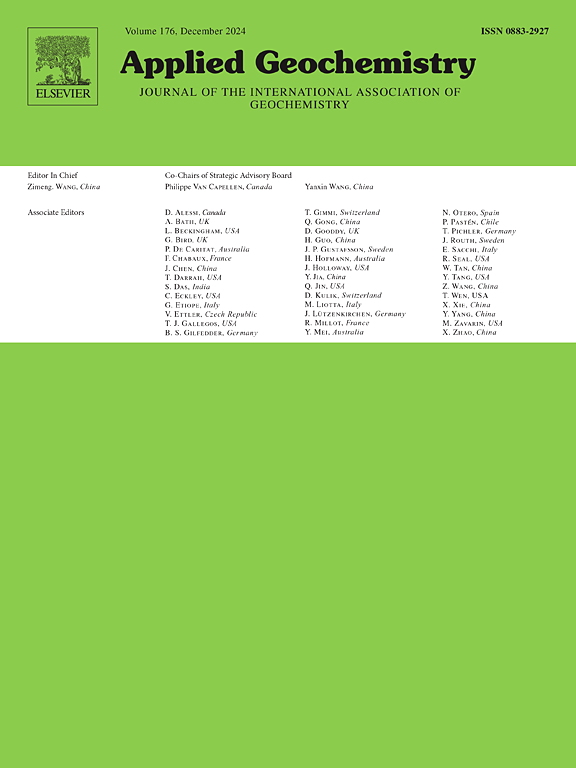Using geochemical and geophysical data to characterise inter-aquifer connectivity and impacts on shallow aquifers and groundwater dependent ecosystems
IF 3.1
3区 地球科学
Q1 GEOCHEMISTRY & GEOPHYSICS
引用次数: 0
Abstract
Understanding inter-aquifer connectivity within sedimentary basins is crucial for determining how groundwater extraction will impact groundwater resources and groundwater dependent ecosystems (GDEs). Geophysical, geochemical and radioisotope data were combined to understand whether dewatering for open-cut coal mining in Australia's Galilee Basin will be likely to impact groundwater levels in overlying aquifers sustaining the ecologically significant Doongmabulla Springs Complex and Carmichael River. Groundwater salinities (<300 mg/L), measurable 3H (0.43 TU), and activities of radiocarbon a14C (14.1 – 95.3 pMC) and chlorine-36 R36Cl (78.1 × 10−15 – 161 × 10−15) imply that preferential pathways for groundwater flow and recharge occur through the weathered sub-crop of the Galilee Basin sediments. These high permeability zones occur consistently within 5 km of the mine (and further to the south), where strong overlap in major ion and radioisotope compositions indicates significant groundwater connectivity between aquifers. Elevated groundwater HCO3 and F concentrations and heavy fraction hydrocarbons (>100 μg/L C10–C40) also imply deep groundwater in the coal measures discharges into overlying non-coal bearing aquifers, most likely via faults. Since coal mine dewatering commenced, drawdown has spread preferentially southward from the mine, driven by geological heterogeneity including into aquifers that are not targeted by mining. Drawdown is also migrating gradually into shallow aquifers west of the mine, towards GDEs along the Carmichael River valley. Numerical modelling of the mine's groundwater impacts, which was the basis of the mine's approval, did not anticipate this level of drawdown in shallow aquifers at this stage of mining. Mining impacts on shallow groundwater resources and GDEs, including the Doongmabulla springs and the Carmichael River, may have thus been underestimated and require re-evaluation. This study highlights that multiple lines of evidence must be assessed to carefully develop conceptual and numerical models, and to protect groundwater and GDEs.

利用地球化学和地球物理数据表征含水层间连通性及其对浅层含水层和地下水依赖生态系统的影响
了解沉积盆地内含水层间的连通性对于确定地下水开采将如何影响地下水资源和地下水依赖生态系统(GDEs)至关重要。地球物理、地球化学和放射性同位素数据相结合,以了解澳大利亚加利利盆地露天煤矿开采的脱水是否可能影响上覆含水层的地下水位,这些含水层维持着具有重要生态意义的Doongmabulla Springs Complex和Carmichael River。地下水盐度(300 mg/L)、可测3H (0.43 TU)以及放射性碳- 14c (14.1 ~ 95.3 pMC)和氯- 36r36cl (78.1 × 10−15 ~ 161 × 10−15)的活性表明,加利利盆地沉积物的风化次作物是地下水流动和补给的优先途径。这些高渗透性带持续出现在距矿井5公里的范围内(并进一步向南),主要离子和放射性同位素组成的强烈重叠表明含水层之间存在显著的地下水连通性。地下水HCO3和F浓度升高以及重馏分烃(100 μg/L C10-C40)也表明煤系深层地下水极有可能通过断层向上覆非含煤含水层排放。自煤矿开始脱水以来,受地质非均质性的驱动,矿井的下沉优先向南扩展,包括进入非开采目标的含水层。矿井西部的浅层含水层也在逐渐下降,沿着卡迈克尔河谷向GDEs方向移动。该矿的地下水影响的数值模拟是该矿获得批准的基础,它没有预料到在采矿的这个阶段,浅层含水层会出现这种程度的下降。因此,采矿对包括Doongmabulla泉和Carmichael河在内的浅层地下水资源和gde的影响可能被低估了,需要重新评价。这项研究强调,必须评估多种证据,以仔细开发概念和数值模型,并保护地下水和gde。
本文章由计算机程序翻译,如有差异,请以英文原文为准。
求助全文
约1分钟内获得全文
求助全文
来源期刊

Applied Geochemistry
地学-地球化学与地球物理
CiteScore
6.10
自引率
8.80%
发文量
272
审稿时长
65 days
期刊介绍:
Applied Geochemistry is an international journal devoted to publication of original research papers, rapid research communications and selected review papers in geochemistry and urban geochemistry which have some practical application to an aspect of human endeavour, such as the preservation of the environment, health, waste disposal and the search for resources. Papers on applications of inorganic, organic and isotope geochemistry and geochemical processes are therefore welcome provided they meet the main criterion. Spatial and temporal monitoring case studies are only of interest to our international readership if they present new ideas of broad application.
Topics covered include: (1) Environmental geochemistry (including natural and anthropogenic aspects, and protection and remediation strategies); (2) Hydrogeochemistry (surface and groundwater); (3) Medical (urban) geochemistry; (4) The search for energy resources (in particular unconventional oil and gas or emerging metal resources); (5) Energy exploitation (in particular geothermal energy and CCS); (6) Upgrading of energy and mineral resources where there is a direct geochemical application; and (7) Waste disposal, including nuclear waste disposal.
 求助内容:
求助内容: 应助结果提醒方式:
应助结果提醒方式:


